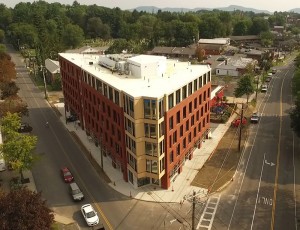Amherst, MA Archipelago Investments, LLC, is no stranger to green building, having been one of the early adopters with their award-winning Boltwood Place in Amherst built in 2012. Kyle Wilson of Archipelago saw the value in the rigorous process of certifying a project with third-party oversight. “It was like having another set of eyes on my project ensuring all best practices were designed and delivered.” Renters are very much tuned in to green building and sustainability in general, and understand the higher quality delivered in a LEED building.
Archipelago is now developing several new projects which will deliver high quality LEED residential to the Amherst market. Cutler Associates, with extensive experience in guiding LEED projects, is the design-builder on the projects. Kendrick Place is a 36-unit, 5-story building in downtown within sight of UMass and Amherst College campuses. Targeting LEED Gold, Kendrick is an example of a project which is going well beyond what the building code requires it to do, to the benefit of the community and the building occupants. The building will use over 25% less energy than a similar code-built structure, will feature a white roof to minimize heat gain, will have each one of its units tested and verified by a third-party for air-tightness and ventilation system performance, and will include an Owner’s Manual for each occupant to ensure that they understand why the green measures were included in their building and how to maintain them. These features, as well as a list of other green building best-practices, are in addition to meeting a list of 18 mandatory “Prerequisites” - standard high-performance building benchmarks which are required for certification.
Following on Kendrick Place will be Olympia Place, a 72-unit 5-story, uniquely designed, building just up the street. These two high-performance projects will introduce 108 new low-impact, premium quality, energy efficient, comfort-oriented apartments to the 5-college market, a market that values sustainability.
Green Building is not new, some builders in Vermont claim to have been “doing it since the 70s, just not calling it green”, but about 20 years ago the United States Green Building Council (USGBC), a non-governmental, non-profit organization, set out to codify what makes a building green. They decided to list the attributes of a green building, with thorough explanations, and then create an incentive system for rewarding ‘green’ projects that attain high levels of sustainability. Through that process, the LEED (Leadership in Energy and Environmental Design) Rating System was born. LEED offers 4 levels of ‘green’: Certified, Silver, Gold and Platinum







